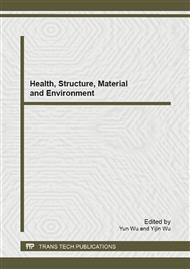[1]
R. K. Singh, et al.: J Hazard Mater, Vol. 155 (2008), pp.523-535.
Google Scholar
[2]
K. Rzeszutek and A. Chow: Talanta, Vol. 46 (1998), pp.507-519.
Google Scholar
[3]
A. Annachhatre and S. Gheewala: Biotechnol Adv, Vol. 14 (1996), pp.35-56.
Google Scholar
[4]
J. D. Rodgers, et al.,: Environ Sci Technol, Vol. 33 (1999), pp.1453-1457.
Google Scholar
[5]
Z. Lazarova and S. Boyadzhieva: Chem Eng J, Vol. 100 (2004), pp.129-138.
Google Scholar
[6]
T. A. Özbelge, et al.: Chem. Eng. Process. Vol. 41, pp.719-730, (2002).
Google Scholar
[7]
A. Dąbrowski, et al.: Chemosphere, Vol. 58 (2005), p.1049.
Google Scholar
[8]
S. Liu and R. Wang: J Porous Mat, Vol. 18 (2011), p.99.
Google Scholar
[9]
C. Y. Yin, et al.: Sep Purif Technol, Vol. 52 (2007), p.403.
Google Scholar
[10]
F. Villacañas, et al.: J Colloid Interf Sci, Vol. 293 (2006), p.128.
Google Scholar
[11]
B. Li, et al.: Catal Today, Vol. 158 (2010), p.515.
Google Scholar
[12]
L. Velasco and C. Ania: Adsorption, Vol. 17 (2011), p.247.
Google Scholar
[13]
X. Chen, et al.: Botanical Studies, Vol. 52 (2011), p.41.
Google Scholar
[14]
J. Przepiorski, et al.: Appl Surf Sci, Vol. 225 (2004), p.235.
Google Scholar
[15]
C. L. Mangun, et al.: Carbon, Vol. 39 (2001), p.1809.
Google Scholar
[16]
V. V. Strelko, et al.: Carbon, Vol. 38 (2000), p.1499.
Google Scholar
[17]
I. I. Salame and T. J. Bandosz: J Colloid Interf Sci, Vol. 240 (2001), p.252.
Google Scholar
[18]
B. Babi, et al.: Carbon, Vol. 37 (1999), p.477.
Google Scholar
[19]
Y. Özdemir, et al.: Micropor Mesopor Mat, Vol. 96 (2006), p.419.
Google Scholar
[20]
Y. M. Tzou, et al.: J Hazard Mater, Vol. 152 (2008), p.812.
Google Scholar
[21]
O. Hamdaoui and E. Naffrechoux: J Hazard Mater, Vol. 147 (2007), pp.401-411.
Google Scholar
[22]
I. Langmuir: J Am Chem Soc, Vol. 40 91918), p.1361.
Google Scholar
[23]
G. D. Parfitt and C. H. Rochester, Adsorption from solution at the solid/liquid interface: Academic press, Norwich, NY (1983).
Google Scholar
[24]
Y. Ho and G. McKay: Chem Eng J, Vol. 70 (1998), p.115.
Google Scholar
[25]
Y. Ho and G. McKay: Process Biochem, Vol. 34 (1999), p.451.
Google Scholar


